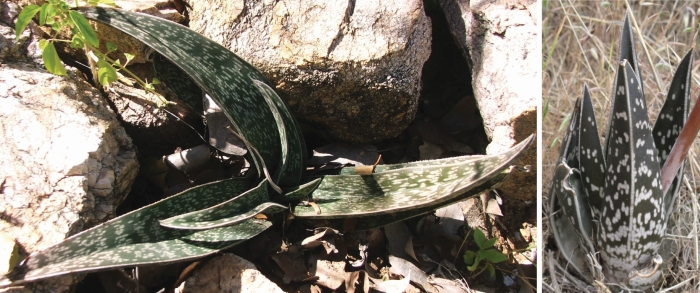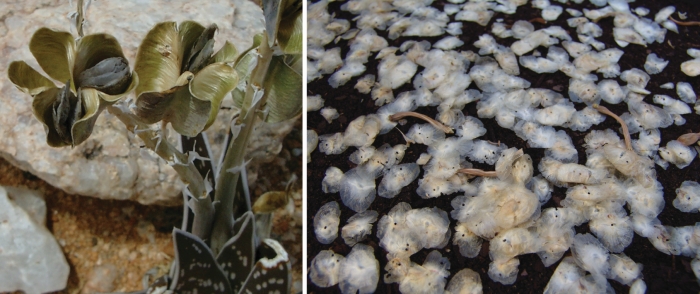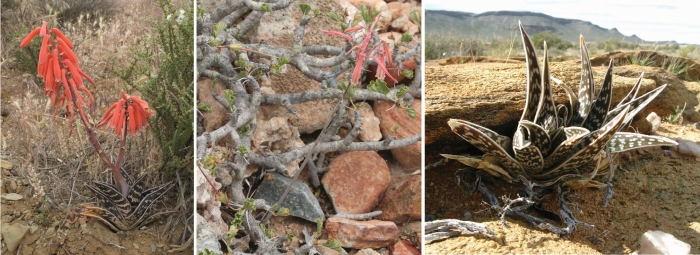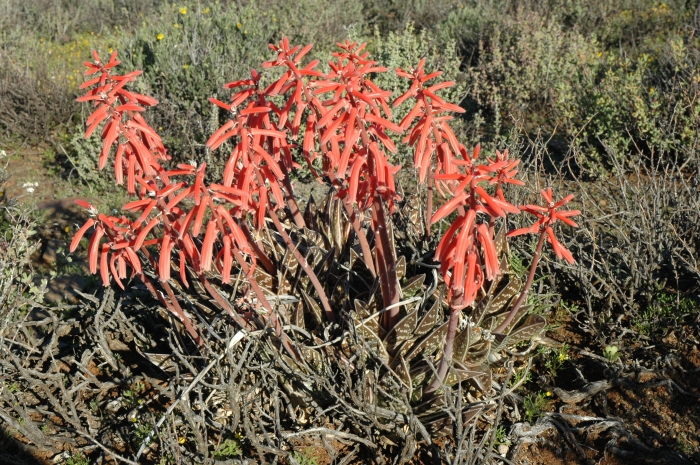Gonialoe genus
Gonialoe (Baker) Boatwr. & J.C.Manning
Family: Asphodelaceae
Common names: partridge aloes, partridge-breasted aloes, tiger aloes, variegated aloes (Eng.); bontaalwyne, bontbees, kanniedood aalwyne (Afr.)
Introduction
The uniquely mottled and folded, three-ranked leaves of these miniature variegated aloes make them very popular for container gardening or as a point of interest in a small rockery. Their comparatively large and showy inflorescences, compared to their small leaf rosettes, further add to the appeal of these plants.

Fig. 1. Gonialoe variegata with camouflaged leaves and highly visible inflorescences. Photo by J.C. Kruger
Description
Description
Gonialoe is a genus of three species that were previously included in the genus Aloe. Following molecular research on the generic-level relationships among the alooids, the genus Aloe was split into several segregate genera: Aloe (true aloes), Aloiampelos (rambling aloes), Aloidendron (tree aloes), Aristaloe (awn-leaf aloe), Gonialoe (variegated or kanniedood aloes), and Kumara (fan aloes).With only three species, Gonialoe is among the smallest of the alooid genera. Gonialoe was originally described at subgenus level as Aloe subgen. Gonialoe by John Gilbert Baker (1834–1920) in 1880 and raised to genus level in 2014. The name Gonialoe is derived from the Greek gonia, meaning ‘an angle’ and the genus name Aloe, in which these plants were originally described, i.e. ‘aloes with angled leaves’. It likely refers to the leaves that are v-shaped (or angled) in cross-section, which is unlike the smoothly rounded leaves (in cross-section) of most other aloes.
Plants consist of small stemless rosettes that either grow solitary or sucker to form small to dense groups. The prominently keeled and lengthwise-folded leaves are arranged in three rows, and are carried erect to spreading or almost horizontally. The three-ranked leaves of the variegated aloes are unique among the aloes, as all other aloes have leaves in rosettes or rarely in two rows (especially in young plants). Leaves are greenish to brownish in colour and variously marked with white confluent spots, often in transverse bands, giving the leaves a mottled appearance. The keel and leaf margin have a bony whitish edge with minute white teeth or can be almost without teeth. This is unlike the often fiercely toothed leaf margins of most other aloes.

Fig. 2. Three-ranked, strongly keeled leaves of G. dinteri with finely toothed margins (left). Photo by E.J. van Jaarsveld and G. variegata with entire margins (right). Photo by N.R. Crouch
Inflorescences of the variegated aloes are erect and can be unbranched or up to 8-branched. The flower clusters (racemes) are usually rather lax and cylindrical, with reddish to pinkish flowers that can be dull or brighter pink, depending on the species. Flowers are cylindrical and slightly decurved with a constriction above the ovary before it widens towards the mouth. Flower buds are horizontal to pendent, while open flowers are pendent.

Fig. 3. Racemes and flowers of G. dinteri (left). Photo by E.J. van Jaarsveld and G. variegata (right). Photo by S.P. Bester
The 3-capsuled fruits dry out and split open at maturity to release small seeds. The seeds have prominent pale wings and are wind dispersed. Gonialoe sladeniana rarely produces seed, which leads to a very slow recruitment rate in this species.

Fig. 4. Gonialoe variegata dried capsules with seeds (left). Photo by J.C. Kruger and winged seeds (right). Photo by G. Nichols.
Species
Gonialoe dinteri (A.Berger) Boatwr. & J.C.Manning (=Aloe dinteri A.Berger)
Plants form solitary, stemless rosettes. Leaves are chocolate brown to deep brownish green, strongly keeled and folded lengthwise, and spreading to almost horizontal, up to 30 cm long, and ± 8 cm wide. The margin and keel of the leaf have a white, bony edge with minute white teeth. Pale rose pink, white-tipped flowers (28–30 mm long) with a bluish bloom are borne in 3- to 8-branched inflorescences (up to 0.9 m high) consisting of a slender peduncle (inflorescence stalk) carrying cylindric, lax racemes (flower heads) between January and March. The bracts on the inflorescences are 3-nerved and shorter than the pedicels (flower stalks). This species is only known from northwestern Namibia and southwestern Angola. It usually grows in sandy or rocky ground or wedged in cracks in limestone or in the shelter of small bushes. It is also sometimes found on granite in the bushveld near the edge of the Namib Desert. The habitat receives very low summer rainfall.

Fig. 5. Gonialoe dinteri. Photo by P. Winter
Gonialoe sladeniana (Pole-Evans) Boatwr. & J.C.Manning (=Aloe sladeniana Pole-Evans)
Plants form small groups of stemless rosettes. Leaves are deep green to gey-green, deeply keeled and slightly folded lengthwise, and rather erect to ascending and tightly bunched together, up to 9 cm long, and ± 4 cm wide. The margin and keel of the leaf have a whitish, bony edge with minute white teeth. Dull pink, green-tipped flowers (20–30 mm long) are borne in usually unbranched to rarely 1- or 2-branched inflorescences consisting of a slender peduncle (inflorescence stalk) carrying cylindric, rather lax racemes (flower heads) between January and February. The bracts on the inflorescences are 1-nerved and shorter than the pedicels (flower stalks). This species is restricted to the mountains of the western escarpment in west-central Namibia. It usually grows on decomposed granites. The habitat has very cold winters, and the distribution falls in the area where low amounts of winter rain gives way to little rain in summer.

Fig. 6. Gonialoe sladeniana. Photo by E.J. van Jaarsveld
Gonialoe variegata (L.) Boatwr. & J.C.Manning (=Aloe variegata L.)
Plants form stemless rosettes that occur solitary or form small to dense groups. Leaves are green to brownish, keeled and slightly folded lengthwise, sometimes with a spiral twist, and rather erect to ascending, up to 15 cm long, and ± 6 cm wide. The margin and keel of the leaf have a whitish, bony edge with very minute white teeth and is often almost entire (without teeth). Dull pink to red, rarely yellow flowers (35–45 mm long) are borne in unbranched to usually 1- or 2-branched inflorescences consisting of a stout peduncle (inflorescence stalk) carrying cylindric, lax racemes (flower heads) between July and September. The bracts on the inflorescences are 1-nerved and longer than the pedicels (flower stalks). This species is widespread from southern Namibia, through the Northern Cape, eastern parts of the Western Cape, western parts of the Eastern Cape, and just entering the western Free State, South Africa. It grows on clayey soils or rarely soils of decomposed granites, in Karoo vegetation and on the edge of the Namib Desert, usually in the protection of bushes. The habitat generally has cold winters, and the distribution falls within both the summer and winter rainfall regions.

Fig. 7. Gonialoe variegata. Photo by S.P. Bester
Conservation Status
Status
All three species in the genus Gonialoe are considered to be of Least Concern (LC). However, they are all listed on CITES Appendix II. These variegated aloes could all be impacted by illegal collecting and habitat disturbance. Gonialoe dinteri and especially G. variegata are distributed over fairly large areas and their populations are considered to be stable. The distribution range of G. sladeniana is smaller than that of the other two species. Even though its population is also regarded as potentially stable, it has a low recruitment rate and it is uncertain how severely it is impacted by illegal collecting. Its assessment as Least Concern could potentially change dramatically if it is shown that collecting of wild plants is a severe threat.
Distribution and habitat
Distribution description
The genus Gonialoe comprises of three species that are distributed from southern Angola, through Namibia to western, southern, and central South Africa. These plants typically grow in very arid, sandy or rocky areas with very little summer or winter rainfall. Plants are often found in the protection of small bushes or wedged into rock crevices.

Fig. 8. Gonialoe plants grow in the shelter of bushes or in rock crevices. Photos: left G. variegata by N.R. Crouch; middle G. dinteri by P. Winter; right G. variegata by J.C. Kruger.
Ecology
Ecology
Inflorescences of the variegated aloes are comparatively large for the size of the plant, especially in G. variegata. These large and highly visible inflorescences are used to attract pollinators, which are rewarded with nectar and pollen. The most likely pollinators of these small aloes include sunbirds, and nectar and pollen collecting insects. These well-camouflaged plants are not often eaten by herbivores, but it has been reported that hyrax, porcupine, and hare occasionally feed on the leaves of these small plants.

Fig. 9. Prominent inflorescences of Gonialoe variegata. Photo by S.P. Bester
Uses
Use
Gonialoe variegata is one of the aloes catalogued from Simon van der Stel’s expedition to Namaqualand in 1685–1686, being first recorded in the Springbok area on 16 October 1685. It is also one of the aloes cultivated by Hendrik Bernhard Oldenland (?–1699) in the Dutch East India Company’s Garden in Cape Town when he was Superintendent there around 1695. Furthermore, this species was the first South African aloe (together with A. melanacantha) for which a figure was published; it appeared in Second Voyage de Siam by Père Tachard (1651–1712) in 1689. It is thus no wonder that this unique plant, which has long been know in cultivation, is one of the most popular aloes to be grown in temperate Europe and the United Kingdom.
There are many superstitions and beliefs linked to these plants, especially for the widespread G. variegata. Many cultures believe that a plant hung in the hut of a young woman will flower when she is fertile. This aloe is often planted on graves, as it is believed to lead to eternal life.
An infusion of plant parts in brandy can be taken for haemorrhoids, while the warmed juice from a leaf is reputed to very quickly and effectively relieve toothache.

Fig. 10. Gonialoe variegata in cultivation. Photo by G. Nichols
Growing Gonialoe genus
Grow
Gonialoe variegata grows well in cultivation, but requires a very well-drained sandy soil. It is best treated as a pot plant, and should be watered sparingly, but more frequently in winter. It can be propagated from suckers and from seed. These plants will flourish with little care or water, hence the common name ‘kanniedood’.
On the other hand, G. dinteri and G. sladeniana do not do well in cultivation outside their natural habitats. These plants could, however, be grown in a glasshouse under strictly controlled conditions. A large container with sandy soil that drains well is required. Since these plants are naturally adapted to very arid conditions, they should not be over-watered and should be protected from excessive rain. They are also sensitive to frost. Especially G. dinteri should be allowed to die down to the leaf bases and to become dormant in winter.
References
- Baker, J.G. 1880. A synopsis of Alooineae and Yuccoideae. The Journal of the Linnean Society, Botany 18: 148–241.
- Bornman, H. & Hardy, D. 1971. Aloes of the South African Veld. Voortrekker Pers. Johannesburg
- Glen, H.F. & Hardy, D.S. 2000. Aloaceae (First part): Aloe. In: G. Germishuizen (ed.), Flora of Southern Africa, Vol. 5, Part 1, Fasc. 1: 1–159. National Botanical Institute, Pretoria.
- Grace, O.M., Klopper, R., Smith, G.F., Crouch, N.R., Figueiredo, E., RØnsted, N.E. & Van Wyk, A.E. 2013. A revised generic classification for Aloe (Xanthorrhoeaceae subfam. Asphodeloideae). Phytotaxa 76,1: 7–14.
- Jeppe, B. 1969. South African aloes. Purnell, Cape Town.
- Loots, S. & Craven, P. 2004. Aloe dinteri. The IUCN Red List of Threatened Species 2004: e.T46722A11078283. https://dx.doi.org/10.2305/IUCN.UK.2004.RLTS.T46722A11078283.en. Accessed on 2022/09/19.
- Loots, S. 2004. Aloe sladeniana. The IUCN Red List of Threatened Species 2004: e.T46725A11078728. https://dx.doi.org/10.2305/IUCN.UK.2004.RLTS.T46725A11078728.en. Accessed on 2022/09/19.
- Manning, J.C. et al. 2014. A molecular phylogeny and generic classification of Asphodelaceae subfamily Alooideae: A final resolution of the prickly issue of polyphyly in the alooids? Systematic Botany 39: 55–74. http://dx.doi.org/10.1600/036364414X678044
- Mtshali, H. & von Staden, L. 2018. Gonialoe variegata (L.) Boatwr. & J.C.Manning. National Assessment: Red List of South African Plants version 2020.1. Accessed on 2022/09/19.
- Reynolds, G.W. 1950. The aloes of South Africa. Trustees of the Aloes of South Africa Book Fund, Johannesburg.
- Smith, G.F. & Van Wyk, B. 2008. Aloes in southern Africa. Struik, Cape Town.
Credits
Ronell R Klopper
National Herbarium
October 2022
Acknowledgments: the author thanks S. Pieter Bester, Neil R. Crouch, Japie C. Kruger, Geoff Nichols, Ernst J. van Jaarsveld and Pieter Winter for kindly supplying the images used in this contribution.
Plant Attributes:
Plant Type:
SA Distribution:
Soil type:
Flowering season:
PH:
Flower colour:
Aspect:
Gardening skill:
Special Features:
Horticultural zones






Rate this article
Article well written and informative
Rate this plant
Is this an interesting plant?
Login to add your Comment
Back to topNot registered yet? Click here to register.